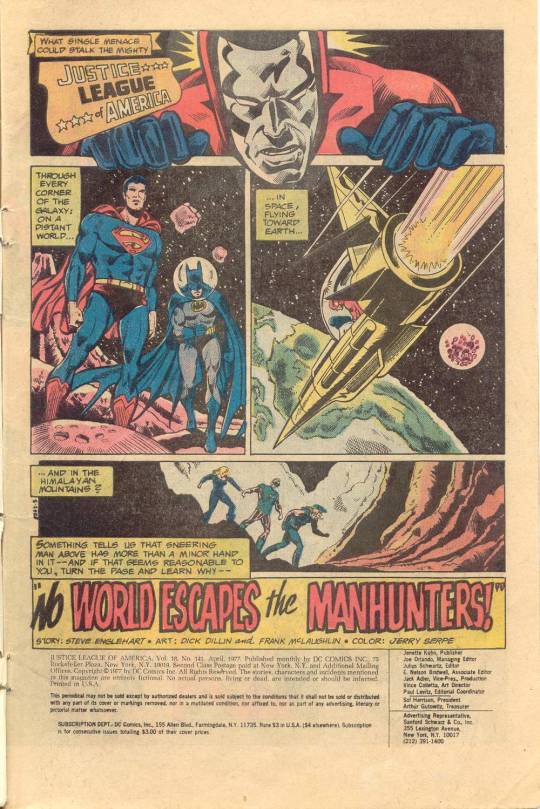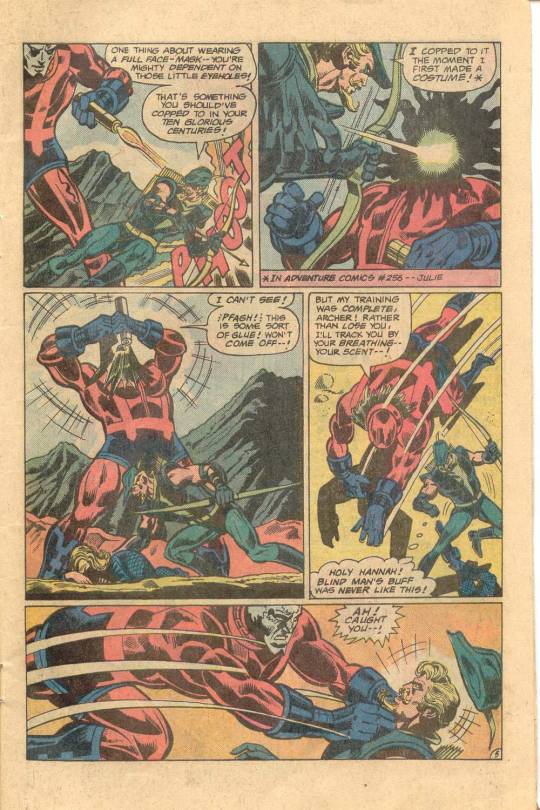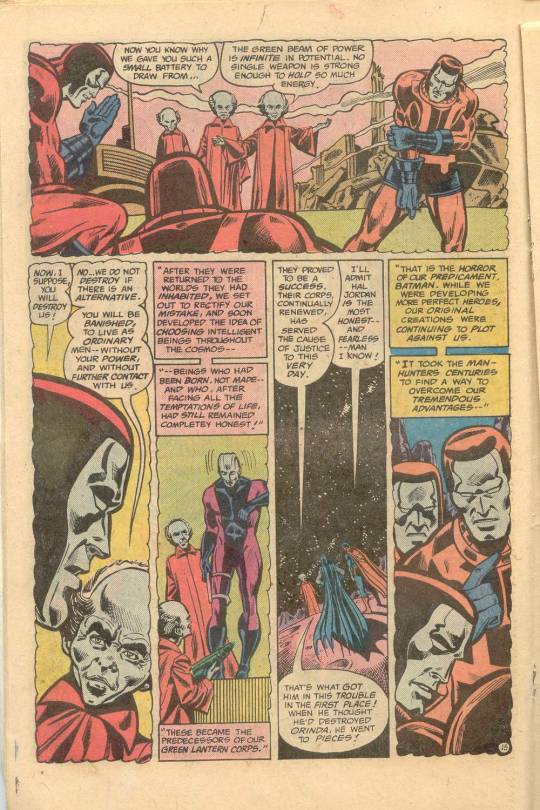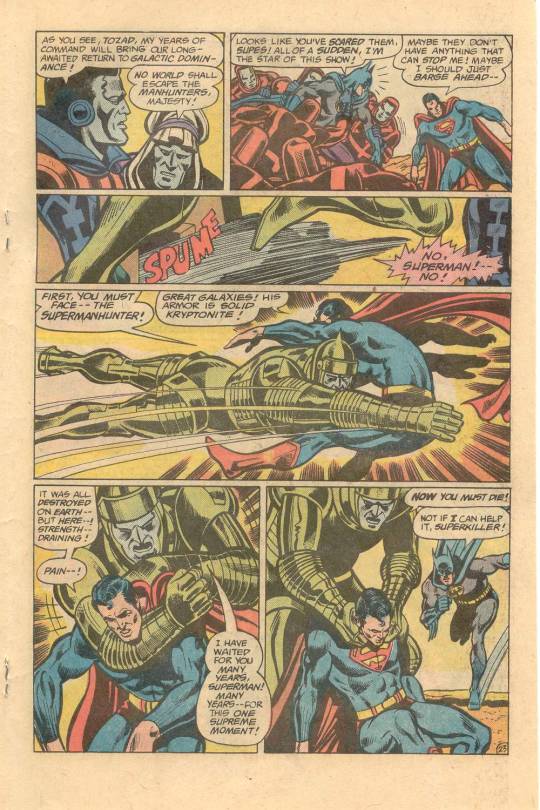#ernie chua
Back to back subscription copies meant that I also got the next issue of JUSTICE LEAGUE OF AMERICA during this period. It was another great issue in the all-new giant format, a big ol’ chunk of new comics every month. Like this month’s FLASH, the cover is by Rich Buckler again inked roughly by Frank Springer. It’s always mystified me a bit the choices DC made on its covers during this period. Somebody over there clearly liked them, but so many of them were poorly or muddily-inked, including the majority of the Ernie Chua/Chan ones. The interiors always looked crisper and cleaner, and I still can’t quite fathom why they thought this approach looked good on the most important page of each issue.

This is the second half of the story begun the previous month involving the intergalactic Manhunters and their attempts to besmirch the reputation of Green Lantern and the Corps he represents. It was also evidence of writer Steve Englehart applying everything that he had learned working on AVENGERS for Marvel to its nearest DC counterpart. That included a Roy Thomas-style fascination with connecting dots of continuity across the line and a greater emphasis on characterization and personal melodrama–which in the case of JLA had pretty much been set at zero or close to zero before this. As a reader, I was uneasy about some of the choices Steve made here, because I was invested in the characters and wanted them to all get along. But it definitely made for much more engaging and satisfying stories, especially when things built to a payoff.

So, picking up from last month, the League has divided its forces in three as they attempt to prove that Green Lantern didn’t accidentally destroy a planet as the Manhunters claim. The hard-traveling trio of Green Lantern, Green Arrow and Black Canary make their escape from the Manhunters’ refuge, only to be tracked by the main Earth Manhunter Mark Shaw, with whom they battle and eventually overcome. Shaw is dedicated to the cause, but it’s the cause of justice–he truly believes that GL is guilty.

Headed back to Earth, the bickering Flash and Wonder Woman are ambushed at the League’s satellite HQ by the Manhunter Grandmaster, who seas them within a force-field that also prevents the satellite from getting any power. With limited time and oxygen left to them, Flash attempts to use the rocket they flew in on to boost his speed so that he can penetrate the force-field, as he and Superman did in tandem in the previous chapter. But he fails in the attempt, and Wonder Woman has to catch his badly-injured body.

Meanwhile, off in space, after proving that the destroyed planet Orinda is still there, just cloaked from view, the Guardian gives Superman and Batman the lowdown on the Manhunters. When the Guardians took up their task of safeguarding the universe, they had created the original Manhunters, androids, to be their footsoldiers. But the androids eventually rebelled and had to be put down, and were replaced with human agents who became the early Green lantern Corps. But the androids, their ranks bolstered by human recruits, desire revenge on their creators–and so the object of this entire subterfuge has been to discredit and ruin the Guardians and their Green Lantern operatives.

Back at the JLA satellite, Wonder Woman confesses to a barely-breathing Flash that the reason she’s been such a bitch to him recently is down to her own insecurities about her worthiness to have rejoined the League. Then, Englehart uses one of the darkest bits of continuity in League history to get them to freedom, as Wonder Woman releases the Dharlu creature who is kept captive within the satellite in order to allow the place to function. As the Dharlu had once duplicated Flash’s powers in the past, Wonder Woman is able to use her lasso to compel the creature to work in tandem with her own speed to disrupt the confining force-field. And then Wonder Woman, the champion of the oppressed and the downtrodden, seals the helpless Dharlu back into the JLA computer core without more than a token show of remorse. It will never be heard from again, and presumably perished when the satellite fell from the sky some years later. Thanks, Wonder Woman!

Back on Orinda, Superman and batman fight their way towards the mechanism that keeps the planet cloaked–once it’s disabled, the Manhunter’s ruse will be apparent for all to see. Unfortunately for them, the Manhunters have a Supermanhunter in reserve, one whose armor is made of solid Kryptonite. Despite being battered bloody, Superman tells Batman not to come to his aid, but rather to complete their mission. On Earth, Wonder Woman and Flash attempt to come to the aid of Green Lantern, Green Arrow and Black Canary, but they’er all beaten by the Manhunters.

Better news is taking place off in space, though, where batman has been able to battle his way to the Illusiotron keeping Orinda cloaked and turn it off. Even better for the Leaguers on Earth, they weren’t beaten by the Manhunters but rather took their places, switching costumes with them so that they could infiltrate undetected. And poor Mark Shaw is horrified to learn that what the League has been telling him about the Manhunters’ duplicity is true, and he destroys the Grandmaster in hand-to-hand combat, who turns out to have been one of the original androids all along. Shaw vows to make use of his Manhunter training to redeem himself. And only one question is left remaining: when the emergency signal went out, the Atom, Aquaman and the Elongated Man didn’t respond in any way. So where are they?

And once again, the issue closed with the 100 Issues Ago feature, this time spotlighting the first appearance of the League’s recurring enemy, the Key from JLA #41 in 1965. I loved this feature, almost more than the comic itself.
Post link
My subscription copy of FLASH turned up right around this time, and it was a good one. How cold I not like it, given that it featured a young character who drew his own comics and super heroes, just like I did. The cover on this one is by Rich Buckler, who began being used for covers widely throughout the line at around this time, though not as exclusively as Ernie Chua/Chan or Nick Cardy before him. Buckler’s covers were always a bit hit-or-miss with me, often depending on who was inking him. This one suffers from some unattractive inking by Frank Springer.

Inside, though, consistency reigned, as this was another story produced by the iron man team of writer Cary Bates and artist Irv Novick. These guys produced a long string of issues throughout my youthful buying years, and that consistency made FLASH a very safe bet to buy (or subscribe to). You knew exactly the kind of story that you were going to get, and the style in which it would be told. Cary, in fact, would continue with the series, through several editor changes, until its wrap-up in 1985 at issue #350–over a hundred issues from this one.

The story opens with Barry Allen testing out a new camera he bought among the throngs of Central City, when he catches a glimpse of Daphne Dean, his childhood sweetheart turned movie actress, among the crowd. But before he can catch up with her, there’s an emergency and the Flash is needed–Heat Wave is robbing a jewelry emporium, using his flame-based talents to cause the air to shimmer like hot tarmac. Flash makes short work of him regardless.

Returning home, Barry and Iris are visited by a Doctor who tells them that Daphne is suffering from amnesia due to a blow on the head she received during a film shoot. As she has no immediate family, the Doctor feels that spending time with Barry will help to jog her memory, which the Allens agree to. Meanwhile, next door, Barry’s young neighbor Barney Sands watches news reporting of Flash’s defeat of Heat Wave and then imagines the Scarlet Speedster up against the Master Villain he has invented in his imagination.

This being a Julie Schwartz comic book, we next focus in on a gaseous alien being who has arrived at Earth. This entity craves new experiences, and is looking for a thrill. It briefly considers possessing Daphne Dean but instead is drawn by the powerful imagination of Barney Sands. Using his drawing of Master Villain as its template, it incorporates itself into a three-dimensional realization of the character that Barney has made up, literally pulling the drawing off of his drawing board.

A brief pause here for Jenette Kahn’s second publishorial, this one adorned not with a Neal Adams caricature but rather a horribly-reproduced photograph. It’s another stump speech for her pet project of the era, Dollar Comics

Master Villain makes his presence known by walking into the main Police precinct and tearing up the joint. But he’s got so many powers that nobody can stop him. The Flash shows up to confront him, and the two wage a super-powered duel of wits, one that ends in a draw in which both the Flash and Master Villain are too discombobulated to continue fighting. But Master escapes, vowing to get the Flash next time. And Flash is confused by all of this–why his foe seemingly attacked the police for no reason, his bizarre assortment of powers, and the fact that he talks like a kid.

And as the issue closes, we focus in on Daphne Dean, having broken away from nursemaid Iris Allen, as she makes a clandestine phone call to an unseen confederate. Her amnesia is a subterfuge, and she’s about to lower the boom on Barry Allen in some nefarious-seeming way! Elsewhere, recognizing that it was his own creation that was tearing up the Police, Barney Sands comes to the only conclusion that he can: he’s going to need to invent a new super hero to take down Master Villain. To Be Continued…!
Post link


